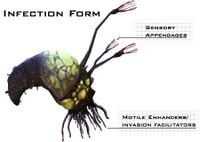Infection Form: Difference between revisions
From Halopedia, the Halo wiki
No edit summary |
No edit summary |
||
| Line 1: | Line 1: | ||
[[Image:Flood3.jpg|right|200px]] | [[Image:Flood3.jpg|right|200px]] | ||
[[Image:BabyFloodCloseup.jpg|right|thumb|200px|The Infection Form in | [[Image:BabyFloodCloseup.jpg|right|thumb|200px|The Infection Form in Halo 2]] | ||
[[Image:Infectionforms Halo1.jpg|thumb|200px|Infection Forms feeding on fallen corpses]]The '''Infection Form''' is the first stage of the [[Flood]]. It is considered to be the organism's "natural" state. It is also referred to as the "spore form". | [[Image:Infectionforms Halo1.jpg|thumb|200px|Infection Forms feeding on fallen corpses]]The '''Infection Form''' is the first stage of the [[Flood]]. It is considered to be the organism's "natural" state. It is also referred to as the "spore form". | ||
Revision as of 20:56, February 8, 2007
The Infection Form is the first stage of the Flood. It is considered to be the organism's "natural" state. It is also referred to as the "spore form".
Background
The Infection form falls under the Kingdom Protoctista, Phylum Protozoa, Sub-Phylum ApicomplexaTemplate:Fact, and evolved from mutualistic protozoa colonies over time, different sub-species developed. Each sub-species with their own adaption that can support the rest of the colony. Over more time the colonies must have evolved into complete organisms; they no longer consist of specialised protozoans, their tissue consists of highly evolved cell types that are new to science.
The spore Flood form is nearly harmless at first glance, but once it gains physical contact with a biological host it becomes highly virulent. Small tendrils underneath its "body" penetrate the skin and unleash an attack on the host's nervous system. First, it paralyzes the host's body. Once this is accomplished, it rewrites the neural pathways of the victim's brain with it's tendrils, forcing a resonant frequency match between its neural signals and the host's. Then it releases Flood DNA which overwrites host DNA and causes the host to mutate. When this is done, it starts to edge its way into the body, slowly moving organs out of the way so it can nest itself into the chest cavity of its host. If a match cannot be obtained, the host is left alone and cannot be used.
At this time, the only known human subject to be incompatible with Flood Infection Forms is Sergeant Johnson, due to his contracting Boren's Syndrome from the residual radiation of Plasma Grenades. There are theories on other species immunities to the flood, such as the Hunter's lack of a central nervous system[1].
Combat
Infection Forms are extremely fragile, and easy to defeat by themselves. Unfortunately, they are never by themselves. Dozens of Infection Forms usually follow Combat Forms and Carrier Forms into battle, infecting new victims while they are wounded or distracted in fighting the other forms [2].
The easiest weapons to use to destroy them are Assault Rifles, Shotguns, SMGs, and Grenades, as they usually move in swarms and one burst from these weapons can eliminate many of them. If the victim does not have a shield engaged, the forms will latch on to the victim and begin draining its energy. Jumping or other aggressive actions can get them to detach. [3]
In Halo 2, they can revive dead but un-dismembered Combat Forms by burrowing into them, greatly increasing their threat level. If the player inflicts enough damage to the prone Combat Form it will disintegrate completely and become useless (Grenades/explosives are most effective, Energy Swords and the Brute Shot melee are also found to be effective)[4].
Trivia
- The Infection Form has appeared in two Action Figure sets: the Halo 1 Flood Carrier Form Action Figure and the Halo 2 s8 Master Chief v4 Action Figure. The differences between the two versions were significant, namely the first Infection Form featured a detachable membrane that revealed the internal organs of the creature.
References
| |||||||||||||||||||||||||||||||||
